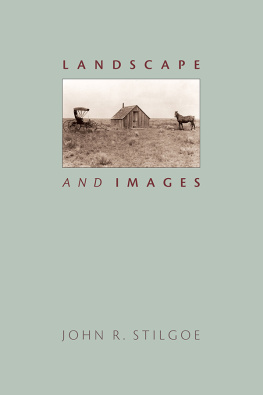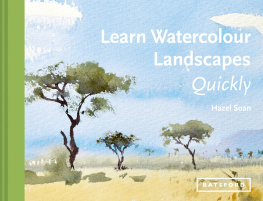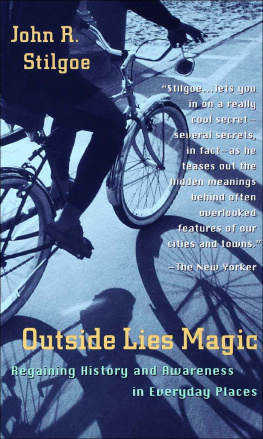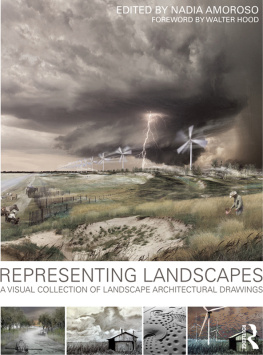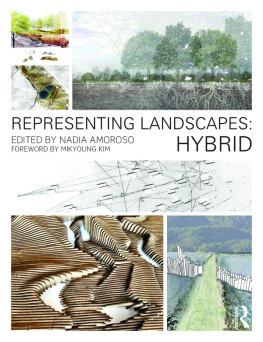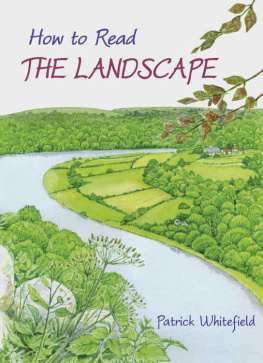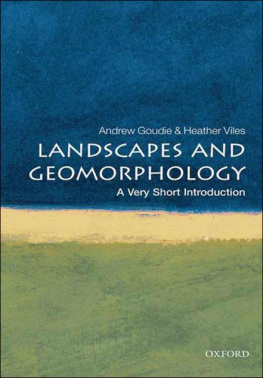University of Virginia Press
2005 by the Rector and Visitors of the University of Virginia
All rights reserved
Printed in the United States of America on acid-free paper
First published 2005
First paperback edition published 2015
ISBN 978-0-8139-3753-3 (paper)
9 8 7 6 5 4 3 2 1
The Library of Congress has cataloged the hardcover edition as follows:
LIBRARY OF CONGRESS CATALOGING-IN-PUBLICATION DATA
Stilgoe, John R., 1949
Landscape and images / John R. Stilgoe.
p. cm.
Includes bibliographical references and index.
ISBN 0-8139-2321 -2 (cloth : alk. paper)
1. LandscapeUnited States. 2. Landscape photographyUnited States.
3. United StatesGeography. I. Title.
EI61.3.S754 2005
917.3dc22
2004020122
For Eleanor Norris
PREFACE
Walking proves pleasant in a mediated age. Away from cinema, television, video, and computer screens, and away from headphones and cell phones too, the walker courts discovery.
Encountering landscape involves little more than glancing around, even while driving a car or sipping a drink aboard Amtrak. Bicycling, canoeing, horseback riding, and cross-country skiing enable observation, discovery, and delight. But walking especially opens on so much that the surfeit almost stuns.
Landscape designates shaped land. Here follows no paean to wilderness, although land unshaped by people gets some cautious examination. Here follows no praise of wholly shaped structure and space either, and especially no analysis of indoor space. But everything else, rural, suburban, and urban, is fair game, and the astonishing amount of space, and range of variation, lure the walker who can never walk it all.
Physical exercise needs space, but a little spice helps it along. Walking and looking around flex muscles and lungs, and eventually stretch the mind too. Anyone who realizes landscape, who notices carefully enough to make it discrete and real, encounters a subject worthy of lifetime study in the open air and in libraries alike.
ACKNOWLEDGMENTS
Boyd Zenner, acquiring editor at the University of Virginia Press, conceived this project. Without her initial idea and continued gracious support, it would have remained not even a dream.
The editors in whose journals appeared earlier versions of the chapters deserve much credit, and I happily provide it here. Editors not only refine the ideas of writers, but by their very existence cause at least some writers to think more than twice about concepts and prose alike.
My students deserve much credit too. Many of the essays began in direct response to student questions, sometimes shouted from the back of lecture halls or tentatively asked around the seminar table, but far more often posed in office hours. Sometimes questions produce a new lecture for a course, and in time the lecture becomes a journal article.
Friends and colleagues deserve mention here, especially Daniel Aaron, Thomas Armstrong, Robert Belyea, Steve Forti, Suzanne Jevne, Arthur Joseph, Phillip Joseph, Eleanor Norris, and John Opie. As young boys, Stephen DuLong, Joseph McGuire, Richard Newey, Chester Paskow, and the late Harry Merritt went exploring with me in sandpits and salt marshes and old fields and cutover woods, all of us ranging constantly over the little coastal town in which I still live. In later years Suzanne Jevne and Marcia Zottoli Stone wandered around with me too, enjoying the freedom of bicycles, then a very-high-mileage 1950 DeSoto in which each enjoyed a wreck caused by my inattention to stumps and swamps. Theodore Baldwin, friend, neighbor, and retired police officer, began instructing me in looking acutely when I backed the DeSoto into his sparkling new car, and still suggests landscape elements that I might investigate.
My family deserves much credit too, not only for observations shouted or whispered to me but for enduring thousands upon thousands of stops to make photographs. Adam and Nathaniel, our grown twin sons, proved to be extraordinarily patient, intrepid, and sometimes serendipitous explorers of landscape, and they still make extremely useful suggestions. My wife, Debra, not only makes all exploration special, but remains the reason I come home.
A NOTE ON THE ILLUSTRATIONS
Except as noted, all of the illustrations either are in the authors collection or are photographs made by the author. Exploring the national landscape produces haphazard encounters with rummage sales, flea markets, barn auctions, and trash set out for collection. Two of the period illustrations included here turned up in a late-eighteenth-century volume of sermons purchased at a farm sale on a Pennsylvania back road. Libraries prove integral to landscape and image research, but a mass of old books and ephemera at a farm machinery auction can be useful too.
INTRODUCTION
Landscape inveigles. Trees and highways, rivers and villages, hills and urban sprawl become more than view or setting altered by weather or slant of light or ideology. Looking at landscape, realizing it, perhaps ordering it in painting, photography, and other representation reward a willingness to be cajoled, surprised, reassured, ensnared, but often misled. Analyzing landscape slams traditional academic inquiry against serendipity and intuition. Always analysis begins in just looking around, noticing the nuance that becomes portal.
Just looking around drifts out of fashion nowadays. Frenzy scars too many over-long workdays, and high-speed or congested highway traffic makes pleasure driving rare. Cell-phone calls interrupt the walker and distract the motorist and the railroad passenger. Walking and running become merely physical exercise often taken in such harried, collisionprone locations that health-club treadmills satisfy more completely. In sinister ways, suspicion attaches to watchers. The walker stopped to examine an old building, the motorist pulled over to scrutinize the last suburban farm fields, even the shopper stopped to watch playground activity becomes suspect. People ignore landscape and its constituent elements, but they see observers as potential thieves, kidnappers, land developers, Environmental Protection Agency operatives, and worse. Since the terrorism of September 11, 2001, citizens and law enforcement officers alike scrutinize anyone who gazes too long at railroad trains, bridges, water-supply towers, chemical plants, oil refineries, industrial waterfronts, skyscrapers, airports, or even the rights-of-way of natural gas lines buried beneath a forest. Paranoia worsens if the observer makes a photograph, even a sketch or a painting. Despite constitutional guarantees and a surfeit of laws protecting looking and photography, once-innocent and honorable activities now require commendable guile.
Underlying suspicion lurks distrust of anyone who observes what most miss. Americans learn in kindergarten to not look from classroom windows. Even looking around the classroom becomes forbidden, evidence of an undirected mind or a willingness to cheat. Since 1900 formal education has involved chiefly learning to listen to words and to manipulate numbers and written words. The Scholastic Assessment Test includes no visual-acuity section to complement the sections that evaluate verbal and quantitative reasoning. Despite a century of cinema, and the explosive growth of television after World War II, despite the subtle and provocative power of video, animation, and video-based games after 1980, despite the astounding power of hypertext-based Internet imagery after 1990, formal education includes almost nothing visual. By third grade students figure out that art is far less important than mathematics, and that looking around produces admonition.

